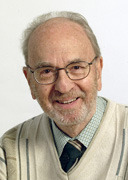This themed collection of articles in Dalton Transactions is dedicated to Ken Wade, who very unexpectedly passed away on 16th March 2014. While this sad loss is the reason for this commemoration, it is an honour for me to write this preface.
I had the pleasure and privilege of getting to know Ken personally during my student days at Durham, a relationship that continued when, much more recently, I became a colleague in the same Department.
I first met Ken when, as a second year undergraduate, he introduced us to aspects of structure and bonding. Only after looking up the subject in the textbooks, did I realise that the relationships he was describing were in fact ‘Wade’s rules’.
It is a vivid reflection of Ken’s humble and self-effacing character that he himself only ever referred to these rules as polyhedral skeletal electron pair theory (PSEPT) or even occasionally during his lectures or in discussions as “Blogg’s Rules”!
Ken’s pioneering work exploring and explaining the structures of deceivingly unrelated clusters and ring systems, which developed primarily as a result of his insightfulness, logical thinking and intuition, now means that his name is familiar to every inorganic chemist, from undergraduate student to senior research professor.
This work lead to the formalised relationship between structure and electron counting in polyhedral cluster systems: relationships that are known universally as Wade’s Rules (J. Chem. Soc. D, 1971, 792).
This set of deceptively simple rules has been developed and expanded into what are known today as the Wade-Mingos Rules, which continue to be taught to chemistry students worldwide as a fundamental tool of Inorganic Chemistry.
Ken’s research career started in 1954 when he began his Ph.D. at the University of Nottingham with Norman Greenwood, probing the addition compounds of gallium and boron trichlorides. This was followed by two postdoctoral positions: first at Cambridge with Harry Emeléus, working on “assorted reactions of diborane”, and second, at Cornell University with Albert Laubengayer, where he investigated various aspects of organonitrogen-aluminium chemistry.
In 1960, Ken returned to the UK to take up his first independent academic position as a lecturer at Derby College of Technology, before moving north to take up a lectureship at the University of Durham a year later, where his interests in synthetic main group chemistry continued to expand.
Although universally known for his electron counting rules, Ken’s innovative and creative character also led him to be major contributor to the areas of azomethine, lithium amide, organophosphorus, transition metal and organolithium chemistry, to name but a few. Ken officially retired in 1997 and, for the sixteen years leading up to his untimely passing, he remained in the Department holding an Emeritus chair of Inorganic Chemistry.
Throughout his sixty-year research career Ken maintained a tireless enthusiasm and curiosity for chemistry, teaching, writing books and original papers, reviewing articles, attending chemistry meetings, and giving invited lectures around the world. Ken’s numerous contributions to the broad field of chemistry were recognised by his election to Fellow of the Royal Society in 1989, and by his election to President of the Dalton Division of The Royal Society of Chemistry in 1996.
On top of all these achievements, Ken’s enormous abilities as a teacher and leader must not be forgotten. His lectures were always inspiring, and were characterised by being both simple and clear, while delivering a broad spectrum of inorganic chemistry topics.
Every lecture was punctuated by anecdotes and amusing stories – who can forget the colour-blind English spy in Russia – and always demonstrated Ken’s ability for clear, logical thinking, something he continually encouraged and inspired in others, be it through undergraduate tutorials, questions after seminars, or chats in the corridor or around the whiteboard.
This themed collection of papers of 60 papers in Dalton Transactions covers a wide and diverse spectrum of topics spanning inorganic chemistry, something that very clearly demonstrates Ken’s significant and wide-ranging contributions to inorganic chemistry in its broadest context.
The rapidity with which all of the invited authors agreed to contribute their work to this special collection of articles unmistakeably reflects the great esteem and friendship with which Ken was held, and provides a fitting tribute to the man himself, his huge role as a teacher and mentor, and his important and extensive contributions to chemistry… Without a doubt, Ken is very sorely missed.
Philip W. Dyer
Department of Chemistry
Durham University, UK
(Left – cover art for the themed collection kindly provided by Professor Jeremy Rawson, University of Windsor. It features the an image of seminal ChemComm paper from 1971 – click to zoom)












